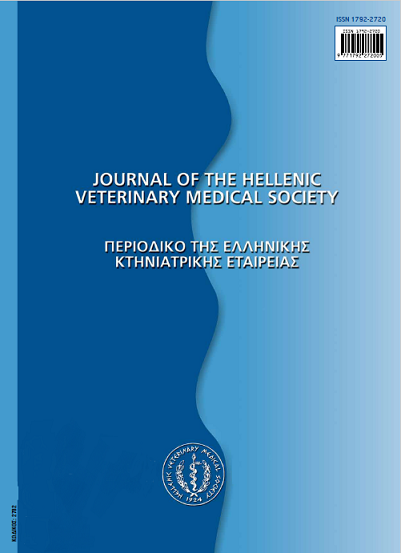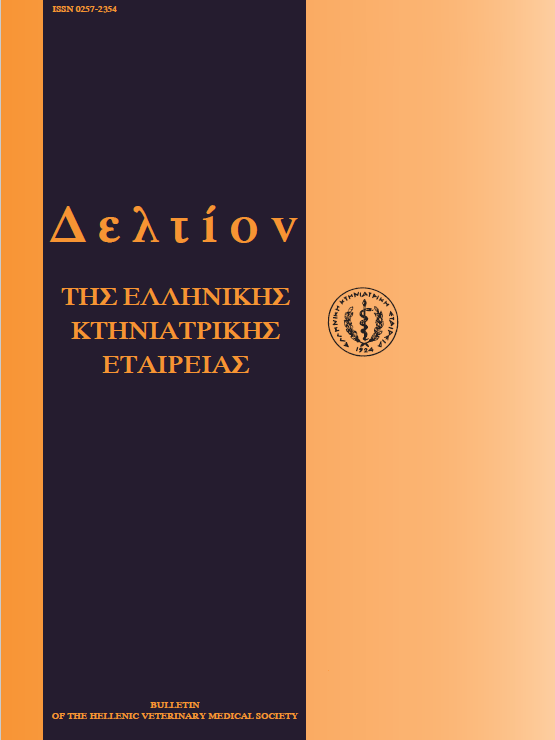Νεότερα δεδομένα για τις τοξίνες του Clostridium perfringens και τις δράσεις τους

Περίληψη
Τα κλωστρίδια εμφανίστηκαν ως ξεχωριστή κλάση πριν από το σχηματισμό του οξυγόνου στην ατμόσφαιρα της γης, περίπου πριν από 2,7 δισεκατομμύρια χρόνια. Η ικανότητα του C. perfringens να σπορογόνεί, το καθιστά ως το πιο διαδεδομένο παθογόνο βακτήριο στη φύση. Ανευρίσκεται σε κάθε πιθανή περιοχή πάνω στη γη, με εξαίρεση την έρημο της Σαχάρας. Επίσης, αποτελεί μέρος της φυσιολογικής εντερικής μικροβιακής χλωρίδας των θερμόαιμων ζώων και του ανθρώπου.Το 2002 ολοκληρώθηκε η διαδικασία ανάγνωσης της αλληλουχίας του γονιδιώματος του στελέχους 13 C perfringens. Από το C perfringens, σε αντίθεση με τα άλλα είδη του γένους, απουσιάζει μεγάλος αριθμός γονιδίων που είναι υπεύθυνα για τηβιοσύνθεση 13 αμινοξέων. Αυτό έχει ως αποτέλεσμα να μην μπορεί να αναπτυχθεί σε περιβάλλον όπου δεν υπάρχουν τα παραπάνω αμινοξέα. Ωστόσο, in vivo, με τη βοήθεια της δράσης των τοξινών του, προκαλεί λύση των κυττάρων και καταστροφή των ιστών, με στόχο την αξιοποίηση τους ως πηγή ενέργειας και αμινοξέων. Οι τοξίνες του C perfringens ταξινομούνται σε κύριες (-α, -β, -ε και -ι), σε δευτερεύουσες και σε εντεροτοξίνη. To C perfringens, με βάση την παραγωγή των κύριων τοξινών του, ταξινομείται σε πέντε τοξινικούς τύπους: Α, Β, C, D και Ε. Η τοξίνη -α είναι η περισσότερο και καλύτερα μελετημένη απότις κύριες τοξίνες του C perfringens. Επίσης, είναι η πρώτη βακτηριακή τοξίνη για την οποία αποδείχτηκε ότι εκδηλώνει ενζυματική δραστηριότητα. Εκδηλώνει αιμολυτική, νεκρωτική και κυτταρολυτική δράση, προκαλεί λύση των αιμοπεταλίων και των λευκοκυττάρων και βλάβη στις κυτταρικές μεμβράνες των ινοβλαστών και των μυϊκών κυττάρων. Η έκφραση τουγονιδίου epa και, κατ' επέκταση, η σύνθεση της τοξίνης -α του C perfringens, φαίνεται να ρυθμίζεται με το σύστημα quorumsensing, χρησιμοποιώντας ολιγοπεπτίδια, αυτεπαγωγείς ή και τα δύο. Το επίπεδο έκφρασης του epa από το C. perfringens στο γαστρεντερικό σωλήνα των υγιών πτηνών είναι χαμηλό, ενώ στα πτηνά που εκδηλώνουν νεκρωτική εντερίτιδα αυξάνεται. Η τοξίνη -β είναι ο κύριος παράγοντας που εμπλέκεται στη νεκρωτική εντερίτιδα του ανθρώπου. Είναι η δεύτερη πιο θανατηφόρα τοξίνη του C perfringens μετά την τοξίνη -ε. Ασκεί την παθογόνο της δράση σχηματίζοντας πόρους με ολιγομερισμό της κυτταρικής μεμβράνης ή εκδηλώνει δράση νευροτοξίνης. Η τοξίνη -ε είναι η πιο ισχυρή κλωστριδιακή νευροτοξίνη μετά την Nτοξίνη της αλλαντίασης και του τετάνου. Αποτελεί τον αιτιολογικό παράγοντα της εντεροτοξιναιμίας και της νόσου του πολτώδους νεφρού στα πρόβατα. Η τοξίνη -ι είναι μέλος των κλωστριδιακών δυαδικών τοξινών που τροποποιούν τον κυτταροσκελετό της ακτίνης. Είναι η λιγότερο τοξική από τις κύριες τοξίνες του C perfringens. Η εντεροτοξίνη αποτελεί την Τρίτησε σειρά συχνότητας αιτία τροφογενούς δηλητηρίασης στους ανθρώπους. Απελευθερώνεται από το C perfringens κατά τη σπορογονία του και όχι κατά την ανάπτυξη του. Δεν φέρουν όλα τα στελέχη C perfringens το γονίδιο (epe), που είναι υπεύθυνο για την κωδικοποίηση της εντεροτοξίνης. Η τοξίνη -θ είναι μια αιμολυσίνη. Παράγεται και από τους πέντε τοξινικούς τύπους C perfringens. Προκαλεί πόρους στην κυτταρική μεμβράνη, ενώ μαζί με την τοξίνη -α, ρυθμίζει τη φλεγμονώδη αντίδραση στον ξενιστή. Η τοξίνη -β2 ασκεί την παθογόνο της δράση μέσω της πρόκλησης πόρων στις κυτταρικές μεμβράνες. Έχει ενοχοποιηθεί για τη νεκρωτική εντερίτιδα του χοίρου, τη νεκρωτική εντερίτιδα του αλόγου, την αιμορραγική εντερίτιδα των βοοειδών, περιστατικά διάρροιας στο σκύλο και, μαζί με την εντεροτοξίνη, για περιστατικά διάρροιας στους ανθρώπους. Πρόσφατα, περιγράφηκε μια νέα τοξίνη που σχετίζεται με τη νεκρωτική εντερίτιδα των κρεοπαραγωγών ορνιθίων, η τοξίνη -NetB, η οποία εκδηλώνει την παθογόνο της δράση με την πρόκληση μικρών υδροφιλικών πόρων στην κυτταρική μεμβράνη.Αλλες τοξίνες είναι η τοξίνη -λ, η τοξίνη -δ, η τοξίνη -μ, η τοξίνη -ν, η τοξίνη -κ, η a-clostripain like πρωτεάση και η νευραμινιδάση/σιαλιδάση (Nam). Οι τοξίνες αυτές δρουν ως ένζυμα, ενώ πολλές δευτερεύουσες τοξίνες δρουν συνεργικά ήσυμπληρωματικά με τις κύριες πορογόνες τοξίνες. Ενδεχομένως να παράγονται και άλλες τοξίνες από το C perfringens, οι οποίες να μην έχουν ταυτοποιηθεί ακόμη. Τέλος, οι δράσεις των τοξινών, κύριων και δευτερευουσών, σε ορισμένα νοσήματα δεν έχουν πλήρως διαλευκανθεί.
Λεπτομέρειες άρθρου
- Πώς να δημιουργήσετε Αναφορές
-
TSIOURIS (Β.Σ. ΤΣΙΟΥΡΗΣ) V. S., GEORGOPOULOU (ΓΕΩΡΓΟΠΟΥΛΟΥ) I., & PETRIDOU (Ε. ΠΕΤΡΙΔΟΥ) E. (2017). Νεότερα δεδομένα για τις τοξίνες του Clostridium perfringens και τις δράσεις τους. Περιοδικό της Ελληνικής Κτηνιατρικής Εταιρείας, 61(3), 241–252. https://doi.org/10.12681/jhvms.14892
- Τεύχος
- Τόμ. 61 Αρ. 3 (2010)
- Ενότητα
- Review Articles
Οι συγγραφείς των άρθρων που δημοσιεύονται στο περιοδικό διατηρούν τα δικαιώματα πνευματικής ιδιοκτησίας επί των άρθρων τους, δίνοντας στο περιοδικό το δικαίωμα της πρώτης δημοσίευσης.
Άρθρα που δημοσιεύονται στο περιοδικό διατίθενται με άδεια Creative Commons 4.0 Non Commercial και σύμφωνα με την άδεια μπορούν να χρησιμοποιούνται ελεύθερα, με αναφορά στο/στη συγγραφέα και στην πρώτη δημοσίευση για μη κερδοσκοπικούς σκοπούς.
Οι συγγραφείς μπορούν να καταθέσουν το άρθρο σε ιδρυματικό ή άλλο αποθετήριο ή/και να το δημοσιεύσουν σε άλλη έκδοση, με υποχρεωτική την αναφορά πρώτης δημοσίευσης στο J Hellenic Vet Med Soc
Οι συγγραφείς ενθαρρύνονται να καταθέσουν σε αποθετήριο ή να δημοσιεύσουν την εργασία τους στο διαδίκτυο πριν ή κατά τη διαδικασία υποβολής και αξιολόγησής της.







